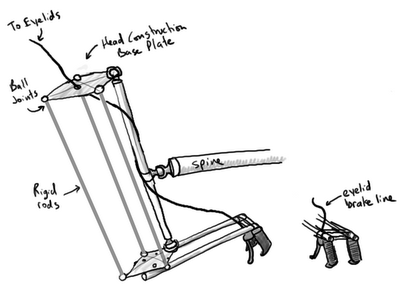These are two of the smaller, one-person dinosaurs from the live-action Walking with Dinosaurs show. That reportedly had a R&D budget of $20 million, so there's no way I'm going to come up with anything as good as this.
What I'd really like to hit is the puppetry of them, which is masterful. To explain what I mean, compare with this video:
In some ways, this second dinosaur is better - the actor's legs and ass aren't hanging out, for one thing. But the movement is so unnatural that it's almost comical. The actor's hips cause the dinosaur's legs to bend mid-thigh, causing an unsightly wrinkle of rubber. The head and neck are so stiff they make batman look agile. The whole thing screams man in rubber suit.
But How?
The 'making of' videos are informative - actually jaw-dropping. From what I can tell, these suits are built as follows:
- There's a full-length structural skeleton, supported by a backpack-like harness worn by the actor.
- The skeleton is supplemented by a few rigid sections, like the ribcage and skull.
- The tail is segmented, made from concentric cross-sections of sturdy foam.
- The skeleton is augmented with "muscles". As with so-called 'fat suits', these are overlapping, muscle-shaped bags filled with polystyrene foam beads. As the skeleton moves, these muscles squash and bulge the way solid tissue would, preventing the skin from folding unnaturally.
- A highly textured skin is attached, in sections, and fastened on with Velcro.
Neckosaurus
I'm not worried about the legs - they're gorgeous pieces of art, but the basic principle is the same as the spider's legs. But the neck..
The head of this creature makes up so much of its personality. If you watch the video carefully, you can see there's tremendous range of motion - the neck can stick straight forward, be nearly right-angles to the body. The head can turn side to side, look up and down, and can even cock to one side like a curious dog.
All of this is amazing when you consider that all of this is happening well out of the actor's reach. What does the head control mechanism look like?
I'd designed something on a scratch pad, but I realized it wouldn't be nearly expressive enough. This is my current thinking:

The upper, diamond-shaped plate is in the head of the monster, and is the platform for building out the skull. Below, there's an identical plate. The two plates' orientations are locked together by a series of rigid rods, affixed with ball- or universal joints. This creates a sort of 'voodoo' mechanism - rotating the lower plate causes an identical rotation in the upper plate.
But.. I've never built anything like this mechanism. Looks to me like there would be tremendous stress on the spine-neck connection. Also, where do I get little ball joints like that? Can I solder copper pipes together, or would the solder just crack apart the first time I bark at an impudent kindergarten Spiderman?

